
article by Belisario
There are many movies that portray heavy metal, but the ones addressing extreme metal could be counted on the fingers of one hand, and all of them are rather recent. In such a mainstream format as cinema, it is no wonder why extreme metal has remained largely out of radar, although it has to be pointed out that the treatment received by more conventional heavy metal has actually never been really thorough. Since the popularity peak of the genre in the late 70s, almost all its appearances on the big screen have portrayed a musical genre essentially grounded in rock music, with no clear differences discernible between both fields. That is the case of Wayne’s World (1992), Airheads (1994) or, for those familiar with Spanish cinema, the two parts of the Isi/Disi saga, Amor a lo bestia (2004) and Alto voltaje (2006). All of them share a stereotyped and humorous vision, which on the other hand always eschews any disquisition of the music itself or its fans.
Basically, there is no big difference with the other movies, much more abundant, which address, more of less deftly, the larger universe of proper rock music, such as Detroit Rock City (1999), School of Rock (2003) and, probably the best of them all as well as an essential classic, This Is Spinal Tap (Rob Reiner, 1984). Now that a commercial product such as Lords of Chaos just brought back to the world of cinema echoes from extreme and underground metal (focusing exclusively on the drama and almost nothing on the music, as could be expected), it is not a bad time to look back and search for other titles which also delved into the darkest and innermost depths of guitar-led styles.
People allergic to spoilers are strongly advised to postpone further reading until all of the commented movies have been watched.
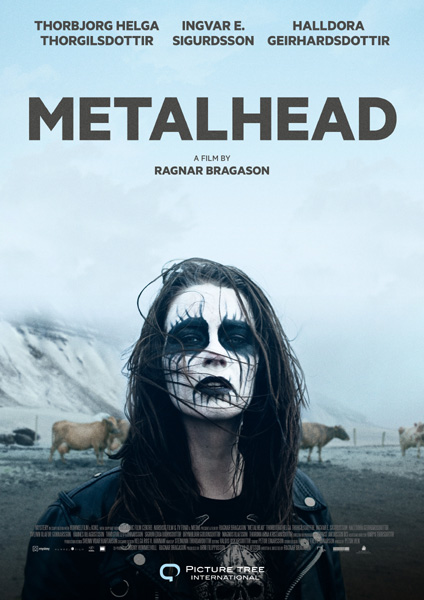
One of the most famous films directly portraying extreme metal is Iceland’s Málmhaus or Metalhead (Ragnar Bragason, 2013), which tells the story of a young girl from a rural background who gets ensnared by black metal after the tragic death of her brother in a terrible accident involving farming machinery. Although in this movie it is possible to hear a nice amount of metal music of different kinds, the main character’s descent into the abyss of extreme metal is closely related with a period of serious personal difficulties, from which she manages to escape with the help of her family and community, to end up switching metal for a sort of atmospheric rock à la Sigur Rós which could please her fellow villagers. There is no explicit mention of black metal as being absolute evil, but its assimilation with negativity and self-destruction is more than obvious, and it is made plain clear that the only thing it can bring to those listening to it is a reveling in loneliness and suffering.
The conclusion brought forth is that the interest in extreme metal is something temporary related to the teenage years, and as soon as that confused and troubled phase is over, the natural thing is that the music stays behind as well. Even the priest who appears in the movie confessing his taste for 80s heavy metal, trying to earn the girl’s trust, makes her see that metal can be something of value during the younger years, but afterwards one must set it aside in order to focus on the obligations of adult life and, therefore, on what society expects from each and every individual. The final message is one of absolute redemption: extreme metal gets assimilated to the tribulations of the teen years, from which it is possible and also mandatory to get out as soon as possible. As a personal or family drama, the plot works quite well, but its moral load becomes almost unbearable to anyone in disagreement with the conclusions set forth.

Somewhat less popular is the French comedy Pop Redemption (Martin Le Gall, 2013), probably little-known beyond the borders of its country of origin. In a totally different tone compared to Metalhead, it tells the difficulties faced by a bunch of black metal musicians that are reaching mature age and struggle to carry on despite the obligations of adult life. A series of circumstances gets them involved in an involuntary homicide, forcing them to escape from the police with hopes to get to play at Hellfest, the biggest metal festival in France, which in the movie is portrayed in an almost advertising manner. On the way, they have to disguise themselves in order not to be recognized, so they adopt the attire of a tribute-band to The Beatles they bump into and whose van they steal. Upon arriving to the next village, they are mistakenly identified by the inhabitants as the original tribute-band, which compels them to play a pop music gig. Little by little they begin to like their new vibe until, once they reach Hellfest, they redirect their style to sound like The Beatles, gathering a great success.
The movie is quite fun in its comedic scenes and its mockery of the metal fan clichés, but the underlying message is not very different from the one found in Metalhead: at some point one must stop fooling around and finally behave according to other people’s expectations, be it playing “normal” music or leading a productive and “reasonable” adult life. I can’t find a better word to define this idea than “redemption”, which is quite appropriate, since it is actually part of the very title. The black metal music played by the main characters at the beginning is more of an obstacle than anything else for being happy and socialize with others, and must be cast aside, along with all personal hindrances and negative thoughts, in order to lead a normal life which implies, among other things, to cut one’s hair, listen to The Beatles and wear normal clothes.
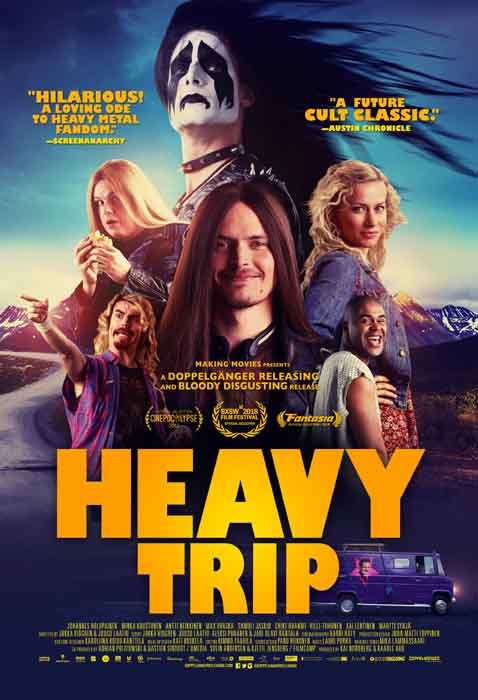
A third film which is quite similar, at least on a superficial level, to the one we just analyzed is the Finnish movie Hevi reissu or Heavy Trip (Jukka Vidgren, Juuso Laatio, 2018), which in many regards could be considered as the Nordic version of Pop Redemption. In it we also find a band, this time a death metal one, hailing from a remote area in Finland and formed by young adults with modest jobs who try to carry their music forward in spite of the obstacles imposed by the world around them. Yet instead of gradually adapting to the circumstances and yielding to what is expected from them, these countryside fellows face all adversities, including the death of one of them, in order to break free from their limited environment and bring their music beyond the borders of their homeland.
The story does not end well in conventional terms, since the band remains rather far from what could be considered as a breakthrough, as they only get to perform briefly in a Norwegian festival before finding themselves in prison, but the conclusion is absolutely glorious, because the only goal these guys had was to get to the next level and play before a like-minded audience, something they achieve by far. The last sentences from the movie confirm that the band will carry on despite everything, no matter what people think, their own material conditions or what people their age should be supposed to be doing, like moving to the big city, looking for a good job, buying a car and a house with a garden and spend the summer on the Spanish southern coast.
In the spirit that pervades Hevi reissu one can easily notice that its creators know perfectly well what they are talking about, and it should not come off as a surprise that this film has been precisely made in Finland, one of the countries in the world where metal is most assimilated in everyday life. As if this were not enough, the movie works pretty well as a comedy, with a series of scenes that are real fun yet also burst with admiration and genuine passion for metal as inspiration for life to be more intense and full, including several live footage passages that are really powerful and such glorious scenes as a leap into the void at a fjord, baths in vomit and reindeer blood, a fist-fight with a wolverine or a supremely epic journey aboard a drakkar.
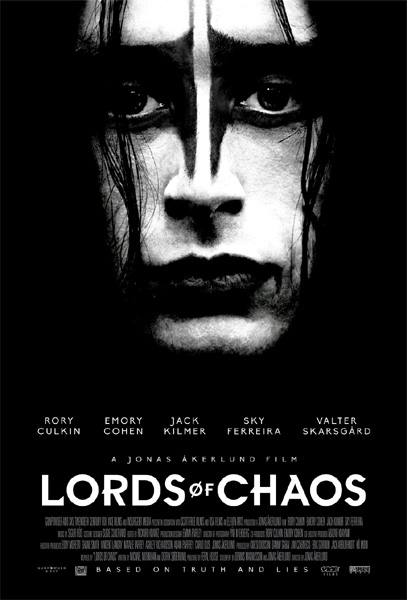
None of that, on the contrary, can be found in Lords of Chaos (Jonas Åkerlund, 2018), which, in spite of capturing very faithfully the aesthetic and atmosphere from the pictures of that era, plainly tiptoes around the nature of the very music, with almost no explanation about its origins, its features or what makes it special. In contrast to the book on which it is based, which elaborated on the exploration of all topics and sources of inspiration that nurtured the whole of the musical, philosophical and cultural influences of Norwegian black metal, the movie focuses almost exclusively on the relationship between Varg Vikernes and Euronymous, against the background of the crimes committed by the “Inner Circle”, which anyone reading this article will already know perfectly well.
Instead of portraying that bunch of frenzied teenagers with no respect whatsoever for human life or society, as profusely described by Michael Moynihan twenty years ago, the screenwriter leans toward cheap psychology, turning Euronymous into a sensitive and faint-hearted kid who plays the tough guy in order to impress its social circle (one is almost happy when he gets killed at the end) and Varg into little less than a victim of harassment who finally takes its revenge by killing the leader of the gang. One does not even need having read the book to conclude that it is highly unlikely that an insecure and spiritless Euronymous would have been so attractive and influential as he was during his lifetime, not to mention that Varg would have never found a need to get rid of someone he had previously taken all prominence and initiative from in such an obvious manner.
If we add to that the express confession from Euronymous admitting, towards the end, that he did everything just to sell records, before deciding to cut his hair (!) –arguably as a sort of symbolic redemption– as well as the supremely unconvincing presence of dozens of groupies everywhere, the result resembles more the story of any successful rock band such as Mötley Crüe (which also had its own death toll, ask poor Razzle) than an extreme metal one, since all the misanthropy, darkness and irrationality that are essential to understand this story are simply cast aside.
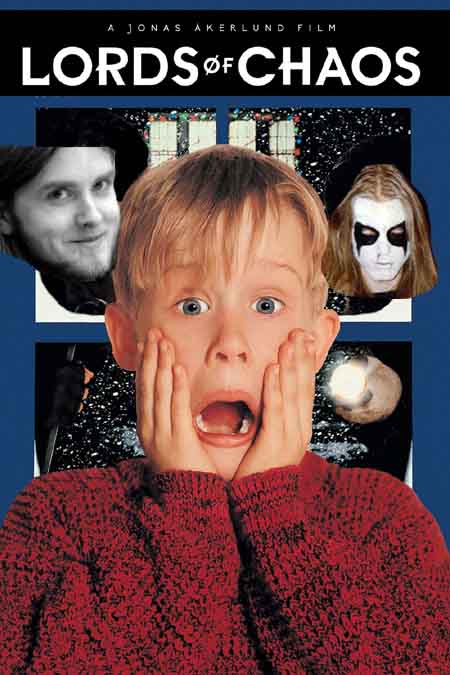
The problem with Lords of Chaos is not what is shows, which is actually carefully presented (in a music video style typical of its director), but the approach adopted, through which one of the most intense, strange and tumultuous metal bands ever to exist is deciphered and interpreted as if it had been a regular rock or punk act that at some point rose to stardom. Maybe this is due to the fact of this being a conventional American production, which demands simple plots and affordable content, or being also a product of Vice Media, a big company that only gets interested in music when it provides sensationalist material in which the musical side is only the last concern, or maybe even of this being the opus of a middle-aged man who played drums in Bathory for a short while before settling down and getting a real job, such as doing music videos for Madonna.
A film adaptation actually immersed in what the namesake book is about would have included more music, more bands, less psychology, more walks through the forest, nature footage and the characters reflecting on their inspirations, in essence, something more artistic, closer to the documentary format and probably also far less linear and marketable as well. What is clear is that the movie as such is more a dose of modern neurosis and morbid fascination than a genuine exploration of an era that, in spite of its overly trite nature, remains nonetheless fascinating, mainly because of its musical, ideological and cultural aspects rather than the events columns it filled back in the day which, let us not forget, pale in comparison, for instance, with the body count left by gangsta rap around the same time.
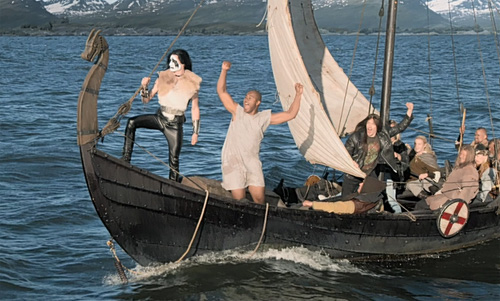
In a tone and style radically different to those of Lords of Chaos, Metalhead and even, in some way, also Pop Redemption, Hevi reissu expresses in a clearer, deeper and more accomplished form the spirit of extreme metal, in this writer’s opinion, than the other three films analyzed, specially the most recent, and it does so without pretense, with a lightness that is worthy of praise and also without giving up its entertaining side. Of all the movies discussed, it is the only one that captures the essence, bursts with metal attitude and philosophy applied to everyday life and is also fucking METAL in each and every scene. Obviously, all the things portrayed are exaggerated, but nothing is disjointed or illogical, and there is no need to use radical turns of events nor dei ex machina which would ruin the plot with nothing substantial to contribute in return.
Maybe due to the fact of them being Finns, the actors understood perfectly what was expected from them and delivered amazing performances, incarnating very genuine characters who through their passion for music overcome all their personal issues and surrounding circumstances, daring to do what they want to do and get away from the boundaries of their native town. Set in a rural environment, the story is probably very similar, if we omit the comedic tone, to the beginnings of any of the Finnish death metal bands from the first wave, which emerged almost exclusively from small-sized municipalities located in the middle of nothing. Last but not least, the song successively written, rehearsed and played on stage by the band is real death metal, somewhat derivative and slightly trivial perhaps, yet firmly anchored inside the metallic frame without yielding to any external influence, and the rendition of it gradually grows in intensity until it manages to make a whole festival go wild.
Hevi reissu is a tale of passion, of madness channeled through creativity and spirit of overcoming, and all this allows this writer to proclaim it as the most genuinely METAL movie he has watched and enjoyed thus far.
Original article written in Spanish: “El metal extremo en el cine”
http://www.elnegrometal.es/el_metal_extremo_en_el_cine.html
Tags: cinema, heavy trip, lords of chaos, metal movies, metalhead, pop redemption


Surprised you did not mention Deathgasm, a favorite among potheads who think Cannibal Corpse is good.
How old are you? Probably not much older than 27, if you don’t recognize Tomb of the Mutilated as a top 20 death metal album. “Elite” millennial metalheads and their historical revisionism
how is a basic Suffocation rehash a top 20 DM album ?
lol, you do realize CC put out their first full length the same year suffocation released their first demo? so who was cloning whomst exactly?
every writer left here is just a butt buddy of the most renowned closeted Zionist left in the metal corner of the interbutts and you’re all slowly being exposed for the astroturfing brainwashed millenial revisionists you are
want proof? just look at the total lack of PHANTOM reviews or coverage even though they just released the best black metal album in the last 20 years of history
but no you would rather swing from kaecks’s shriveled old man nutsack or brag about how much you love rassling/incidental frottage with spandex clad young men
publish this reply and respond I triple dog dare ya
Butchered at birth was very different from what the groove laden CC would become. CC took from Suffocation in so many ways, it was obvious.
No Brett and me aren’t butt buddies.
We will add PHANTOM to the list of bands to review but the list of interesting stuff to review is huge.
Try wrestling once in your life before judging it. It will be one of the hardest workouts in your life and an excellent tool in altercations.
done dawg!!!
I did try rasslin ONCE but I quit immediately like any real hetero cuz i kept getting stiffies /:
looking forward to the PHANTOM perspective! just skip everything else cuz it won’t be as good and the new album EPILOGUE TO SANITY just dropped and boy howdy is it a whopper
if you got stiffies wrestling with men, you aren’t very hetero.
I will bump it to the top of the list, it better be good.
it’s not
Deathgasm was cool.
Plenty of rock movies out there, but yes, not too many about extreme metal.
I always enjoyed the rock movies that have an occult/supernatural aspect.
The Japanese movie (nlt the cartoon) “Detroit Metal City” (2010), has more to do with a member in a visual kei/KISS-type theatrical metal band, but it might have fit in with your article.
Part of the plot makes the viewer believe that metal bands are at war and want to kill each other.
*meant to post Detroit Metal City (2008).
Gumo? Not really about metal but I think very interesting overall.
Punk movies have ironically been less idiotic.
Well at least theres Ace Ventura.
I’d rather fuck a priest than my pussy bitch boyfriend!
Fantastic and well researched foray. Really insightful. We could use kore of your writings here
Glad you liked it! I try to contribute once in a while, when I have time.
hey how come you geezers never cover anything by PHANTOM? maybe look into albums DIVINE NECROMANCY or EIDOLON. black metal so evil that it blasphemes against black metal itself – surely worth more attention than all this navelgazing circlejerk over bullshit that everyone already recognizes for exactly what it is. (((Hollywood))) representations of extreme music ideals are inaccurate? whoa next you’re gonna tell me that my Prius hasn’t saved any icebergs?
icenurgs r like a bad laxative just dont mpve me ya iknow
https://www.youtube.com/watch?v=ZHJFlrXZ3VQ&t=153s
I like more the sound here. Divine Necromancy has a too strong drum sound
cmon bro it’s common knowledge that neither Russians nor women can play metal
bah